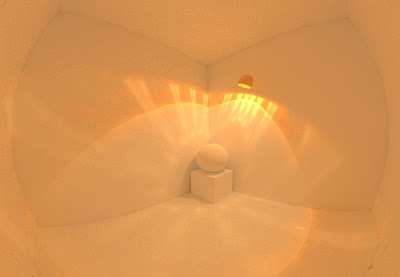Really quick, here are five ways that experience in 3D modeling, animation, texturing, lighting and rendering can help you become a better 2D artist.
1. 3D modeling teaches you patience. Most people who draw could use more patience and attention to detail. 3D modeling teaches you to break a subject down to well-defined chunks and plan out your level of detail before you begin. In 2D mode, drawing on paper or tablet, I noticed that I tended to hurry through pieces and spend less time planning an entire scene (rather than just the foreground, for example) than I did in 3D.
2. Working in 3D teaches you not to be a technique nazi. At some point in creating your newest, awesome-est work, you realize that either a) you have no time to set up some incredible rendering technique, or b) the incredible rendering technique will take too long to render. You're forced to jury-rig a few things and make it happen. Even if the "happen" part means adding significant graphical elements in Photoshop. As a 2D artist, it's easy to look over at your newest mechanical pencil and dream about awesome mechanical drawings, but in reality, nothing is going to happen until some marking object - mechanical pencil or not - touches down on a piece of paper or your Cintiq screen.
3. Animation experience boosts your 2D visualization skills. Most 3D modelers will, at some point, start animating. 3D software just makes it so easy, you HAVE to try it. Once you've learned the basics of animation, you start to change camera POV, you notice how lighting changes how an object looks depending on its orientation, etc. This helps you understand a few key compositional principles, like a) some poses just look better than others, b) a changeup in lighting may really benefit your 2D art, and c) a feeling of depth created by POV/wide angle/narrow angle or even contrast variation adds visual interest.
4. You really learn what texture is. Most 2D artists struggle with this at first. They have pre-conceived notions of what texture is. Bricks look like perfect little red boxes, stacked together, with some pockmarks here and there. Skin is pink and maybe shiny in a dull kind of way. The sky is blue. 3D artists learn almost immediately that texturing is an abstract term comprised of some huge illustration principles, among other things. 3D artists also learn that bringing real-life textures into an image brings an element of chaos and random beauty that they might never think to express in a 2D drawing.
5. Expect more out of your medium. Working in 3D art taught me that there are so many features in 3D software, I could visualize just about anything I wanted to in breathtaking detail. But somehow, when I found myself holding a cracked, yellow pencil over a sheet of copy paper, the concept of "do ANYTHING you want!!!" didn't come naturally. Since then, I've learned that all of the concepts in 3D work - lighting, texturing, and even rendering and animation, still apply in 2D work. And darnit, even that little fact makes drawing things by hand more exciting.



















